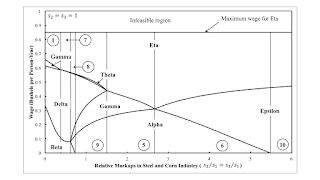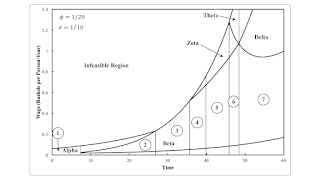This post is an attempt to work through some linear algebra that some have used to understand Karl Marx's Capital. I have recently explained how, in a simple model, prices of production are equal to labor values if the organic composition of capital does not vary among industries. That special case is the setting of volume 1.
In capitalism, workers rent themselves out to their employers. They work longer, under the dominion of capital, than needed to produce the commodities which they purchase with their wages. Marx explains the returns to ownership (profits, interest, rent, etc.) by the distinction between the use value and the exchange value of labor power.
This post removes the special case assumption. It considers certain relationships between the system of labor values and the system of prices of production. These relationships are highlighted towards the start of volume 3. I ignore Hegel, on his head or otherwise.
2.0 Quantity FlowsSuppose a capitalist economy is observed at a given point in time. n commodities are being produced, each by a separate industry. Suppose the technique in use can be characterized by a row vector a0 and a n x n square matrix A.
The jth element of a0 is the amount of labor directly employed in the jth industry in producing one unit of a commodity output from that industry. "We suppose labour to be uniform in quality or, what amounts to the same thing, we assume any differences in quality to have previously been reduced to equivalent differences in quantity so that each unit of labour receives the same wage…" - Piero Sraffa (1960).
The jth column of A is the goods used up in producing one unit of a commodity output. For example, suppose iron is produced by the first industry and steel is produced by the second industry. a1,2 is then the kilotons of iron needed to produce a kiloton of steel. Assume that every good enters directly or indirectly into the production of each commodity. Iron enters indirectly into the production of tractors if steel enters directly into the tractor industry. Assume a surplus product, also known as a net output, exists.
Let y be the column vector of net outputs and q the column vector of gross outputs, both in physical terms. In Leontief's work, y is taken as given. Gross outputs and net outputs are related as:
y = q - A q
Or:
q = (I - A)-1 y
The labor force needed to produce this net product is:
a0 q = a0 (I - A)-1 y = 1
I have taken units in which labor is measured to be such that this labor force is unity. Employment is such that the net output is produced, the capital goods in producing the net output are reproduced, the capital goods used in producing those capital goods are reproduced, and so on.
3.0 Labor ValuesLet ej be the jth column of the identity matrix. The labor force needed to produce this net output is:
vj = a0 (I - A)-1 ej
That is, the (direct and indirect) labor needed to produce a net output of one unit of the jth commodity is vj. The row vector of labor values is:
v = a0 (I - A)-1
4.0 Prices of Production
At any time, market prices are such that different industries are making different rates of profits. Under competitive conditions, without barriers to entry in the various industries, a kind of leveling process is going on.
One can imagine a vector of prices such that this leveling process is already completed with the observed technique and wage. Let p be that row vector of prices of production, with all industries obtaining the same rate of profits.
I need an assumption about the composition of commodities purchased from the wage, w, since I want to explore the labor value embodied in the wage. Accordingly, assume that the wage is a proportion of the final product. The wage ranges from zero to unity, inclusive. The physical composition of the wage is w y. Wages are advanced. Define:
A*(w) = A + w y a0
I gather the vector operation at the end of the above expression is the outer product. Prices of production satisfy the equation in the following display:
p A*(w) (1 + r) = p
where r is the rate of profits. That is, p is a price vector consistent with the observed technique and wage.
By the Perron-Frobenius theorem, the eigenvalue of A*(w) with the maximum modulus is real, positive, and does not exceed unity. The corresponding rate of profits is non-negative. The eigenvector consists of all positive entries. Thus a solution exists for the above equation. Furthermore, the wage and the rate of profits are related by a decreasing function. The maximum wage occurs at a rate of profits of zero. The maximum rate of profits is finite and occurs at a wage of zero.
Prices of production have been found up to a scaling factor. They are generally not proportional to labor values, as Ricardo and Marx knew.
5.0 InvariantsThe scale for prices of production can be fixed by specifying a numeraire. Consider, instead, the imposition of an identity between the system of labor values and the system of prices of production.
5.1 Case 1: Total Gross OutputThe labor value of gross output is equal to the price of gross output if and only if:
v q = p q
Imposing the above condition fixes the scale for prices.
5.2 Case 2: Total Net OutputAlternatively, the labor value of net output is equal to the price of net output if and only if:
v y = p y = 1
I have taken advantage above of the scaling of units of labor time. This invariant is my favorite of the three invariants considered here.
5.3 Case 3: The Rate of ProfitsThe labor value of advanced capital is v A*(w) q, while its price is p A*(w) q. The labor value of profits is:
(1 - w) v y = (1 - w)
The rate of profits does not differ between the system of labor values and the system of prices if and only if:
(1 - w)/[v A*(w) q] = (1 - w) p y/[p A*(w) q]
6.0 Concluding Observation
The above post has defined three invariants, each equating a sum or ratio of labor values to the corresponding sum or ratio in the system of prices of production. Only one invariant can generally hold, though, in the given model. This has led to quite a bit of literature arguing that one of these or other invariants is central to Marx's argument.
Some have another approach. They adopt another model in which all three invariants hold. In fact, more than one such model has been developed.
An approach I find of interest looks at a special composition of final output. Whatever the composition of the final output, one can iterate by looking at the composition of the capital goods used in producing that final output. A number of iterations leads to a composite commodity of close to the output of something like Marx's industry of average organic composition of capital.
Or one can retain an interest in how labor is allocated among industries, while exploring prices of production with an arbitrary numeraire. The fundamental theorem of Marxism holds in this setting. Must one draw quantitative relationships between the system of labor values and the system of prices of production?
Others might want to explore the historical and empirical evolution of the parameters of the model in the post and related models.
Reference- Francis Seton. 1957. The 'Transformation Problem'. Review of Economic Studies 24 (3): 149-160.






















